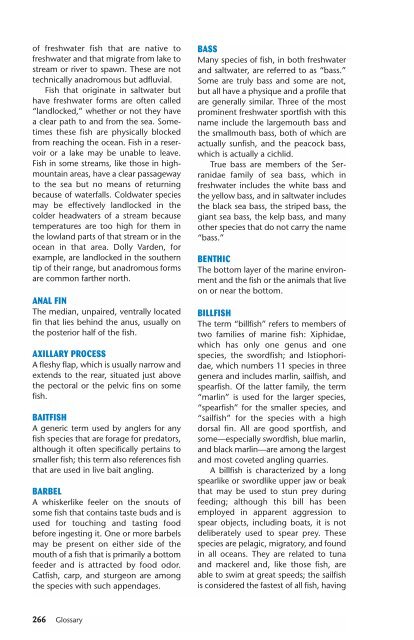Ken Schultz's Field Guide to Saltwater Fish - Macaw Pets store
Ken Schultz's Field Guide to Saltwater Fish - Macaw Pets store
Ken Schultz's Field Guide to Saltwater Fish - Macaw Pets store
Create successful ePaper yourself
Turn your PDF publications into a flip-book with our unique Google optimized e-Paper software.
of freshwater fish that are native <strong>to</strong><br />
freshwater and that migrate from lake <strong>to</strong><br />
stream or river <strong>to</strong> spawn. These are not<br />
technically anadromous but adfluvial.<br />
<strong>Fish</strong> that originate in saltwater but<br />
have freshwater forms are often called<br />
“landlocked,” whether or not they have<br />
a clear path <strong>to</strong> and from the sea. Sometimes<br />
these fish are physically blocked<br />
from reaching the ocean. <strong>Fish</strong> in a reservoir<br />
or a lake may be unable <strong>to</strong> leave.<br />
<strong>Fish</strong> in some streams, like those in highmountain<br />
areas, have a clear passageway<br />
<strong>to</strong> the sea but no means of returning<br />
because of waterfalls. Coldwater species<br />
may be effectively landlocked in the<br />
colder headwaters of a stream because<br />
temperatures are <strong>to</strong>o high for them in<br />
the lowland parts of that stream or in the<br />
ocean in that area. Dolly Varden, for<br />
example, are landlocked in the southern<br />
tip of their range, but anadromous forms<br />
are common farther north.<br />
ANAL FIN<br />
The median, unpaired, ventrally located<br />
fin that lies behind the anus, usually on<br />
the posterior half of the fish.<br />
AXILLARY PROCESS<br />
A fleshy flap, which is usually narrow and<br />
extends <strong>to</strong> the rear, situated just above<br />
the pec<strong>to</strong>ral or the pelvic fins on some<br />
fish.<br />
BAITFISH<br />
A generic term used by anglers for any<br />
fish species that are forage for preda<strong>to</strong>rs,<br />
although it often specifically pertains <strong>to</strong><br />
smaller fish; this term also references fish<br />
that are used in live bait angling.<br />
BARBEL<br />
A whiskerlike feeler on the snouts of<br />
some fish that contains taste buds and is<br />
used for <strong>to</strong>uching and tasting food<br />
before ingesting it. One or more barbels<br />
may be present on either side of the<br />
mouth of a fish that is primarily a bot<strong>to</strong>m<br />
feeder and is attracted by food odor.<br />
Catfish, carp, and sturgeon are among<br />
the species with such appendages.<br />
266 Glossary<br />
BASS<br />
Many species of fish, in both freshwater<br />
and saltwater, are referred <strong>to</strong> as “bass.”<br />
Some are truly bass and some are not,<br />
but all have a physique and a profile that<br />
are generally similar. Three of the most<br />
prominent freshwater sportfish with this<br />
name include the largemouth bass and<br />
the smallmouth bass, both of which are<br />
actually sunfish, and the peacock bass,<br />
which is actually a cichlid.<br />
True bass are members of the Serranidae<br />
family of sea bass, which in<br />
freshwater includes the white bass and<br />
the yellow bass, and in saltwater includes<br />
the black sea bass, the striped bass, the<br />
giant sea bass, the kelp bass, and many<br />
other species that do not carry the name<br />
“bass.”<br />
BENTHIC<br />
The bot<strong>to</strong>m layer of the marine environment<br />
and the fish or the animals that live<br />
on or near the bot<strong>to</strong>m.<br />
BILLFISH<br />
The term “billfish” refers <strong>to</strong> members of<br />
two families of marine fish: Xiphidae,<br />
which has only one genus and one<br />
species, the swordfish; and Istiophoridae,<br />
which numbers 11 species in three<br />
genera and includes marlin, sailfish, and<br />
spearfish. Of the latter family, the term<br />
“marlin” is used for the larger species,<br />
“spearfish” for the smaller species, and<br />
“sailfish” for the species with a high<br />
dorsal fin. All are good sportfish, and<br />
some—especially swordfish, blue marlin,<br />
and black marlin—are among the largest<br />
and most coveted angling quarries.<br />
A billfish is characterized by a long<br />
spearlike or swordlike upper jaw or beak<br />
that may be used <strong>to</strong> stun prey during<br />
feeding; although this bill has been<br />
employed in apparent aggression <strong>to</strong><br />
spear objects, including boats, it is not<br />
deliberately used <strong>to</strong> spear prey. These<br />
species are pelagic, migra<strong>to</strong>ry, and found<br />
in all oceans. They are related <strong>to</strong> tuna<br />
and mackerel and, like those fish, are<br />
able <strong>to</strong> swim at great speeds; the sailfish<br />
is considered the fastest of all fish, having


